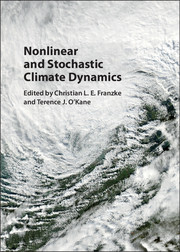Book contents
- Frontmatter
- Contents
- List of Figures
- List of Contributors
- Preface
- 1 Challenges for Ice Age Dynamics: A Dynamical Systems Perspective
- 2 Tipping Points in the Climate System
- 3 Atmospheric Teleconnection Patterns
- 4 Atmospheric Regimes: The Link between Weather and the Large-Scale Circulation
- 5 Low-Frequency Regime Transitions and Predictability of Regimes in a Barotropic Model
- 6 Complex Network Techniques for Climatological Data Analysis
- 7 On Inference and Validation of Causality Relations in Climate Teleconnections
- 8 Stochastic Climate Theory
- 9 Stochastic Subgrid Modelling for Geophysical and Three-Dimensional Turbulence
- 10 Model Error in Data Assimilation
- 11 Long-Term Memory in Climate: Detection, Extreme Events, and Significance of Trends
- 12 Fractional Stochastic Models for Heavy Tailed, and Long-Range Dependent, Fluctuations in Physical Systems
- 13 Modelling Spatial Extremes Using Max-Stable Processes
- 14 Extreme Value Analysis in Dynamical Systems: Two Case Studies
- Index
2 - Tipping Points in the Climate System
Published online by Cambridge University Press: 26 January 2017
- Frontmatter
- Contents
- List of Figures
- List of Contributors
- Preface
- 1 Challenges for Ice Age Dynamics: A Dynamical Systems Perspective
- 2 Tipping Points in the Climate System
- 3 Atmospheric Teleconnection Patterns
- 4 Atmospheric Regimes: The Link between Weather and the Large-Scale Circulation
- 5 Low-Frequency Regime Transitions and Predictability of Regimes in a Barotropic Model
- 6 Complex Network Techniques for Climatological Data Analysis
- 7 On Inference and Validation of Causality Relations in Climate Teleconnections
- 8 Stochastic Climate Theory
- 9 Stochastic Subgrid Modelling for Geophysical and Three-Dimensional Turbulence
- 10 Model Error in Data Assimilation
- 11 Long-Term Memory in Climate: Detection, Extreme Events, and Significance of Trends
- 12 Fractional Stochastic Models for Heavy Tailed, and Long-Range Dependent, Fluctuations in Physical Systems
- 13 Modelling Spatial Extremes Using Max-Stable Processes
- 14 Extreme Value Analysis in Dynamical Systems: Two Case Studies
- Index
Summary
Abstract
In climatic time series abrupt changes are observed. We hypothesize that these abrupt changes are due to nonlinear responses inherent in the climate system, specifically, so-called tipping points.
This behaviour results from non-linear climate response to either external forcing, internal stochastic fluctuations or a combination of both. At some point the forcing will cause the climate to jump from one stable state to another. This scenario is termed a tipping point. The concept of a tipping point is quite broad, but here we shall refrain from any general definitions and consider the following more restricted framework: We consider the climate or some components of the climate as a dynamical system depending on a set of parameters. Factors, not included in the system interacting with components of the system, can then be considered external forcing or stochastic fluctuations. Two common, and often competing, hypotheses are: The climate system's steady state loses its stability and disappears as an external system (control-)parameter slowly changes, so-called b-tipping, b for bifurcation-induced; or fluctuations spontaneously push the climate system from one stable state to another, so-called n-tipping, n for noise-induced.
The cause of the tipping can be very different in the two cases, and especially the possibility of predicting a tipping will be different. In the case that the underlying dynamics or the control-parameter are not completely known, there could still be early warning signals in the statistics of the observed fluctuations prior to a tipping point.
The Pleistocene Climate Record
The Pleistocene climate is documented in a variety of geological records, most prominently in ocean sediment cores and ice cores. These all show that climate has changed abruptly through time both as response to the orbital changes and as a part of internal variability. Figure 2.1, top panel, shows the last 1Myr of the Lisiecki and Raymo stack marine benthic oxygen isotope record (Lisiecki & Raymo, 2005). The record is a proxy for global ice volume, showing the last ten glacial cycles. There is a strong and consistent time asymmetry with rapid warming (terminations) and gradual cooling (inceptions).
- Type
- Chapter
- Information
- Nonlinear and Stochastic Climate Dynamics , pp. 33 - 53Publisher: Cambridge University PressPrint publication year: 2017



